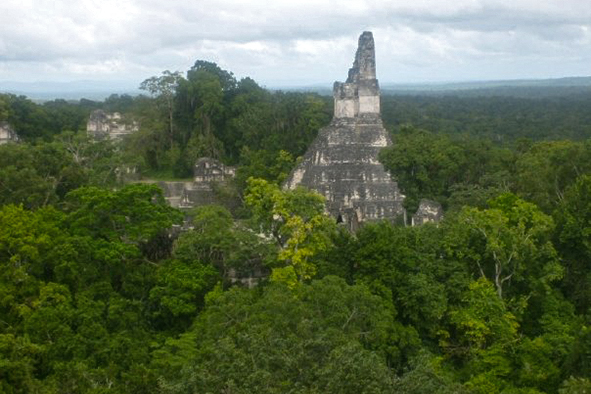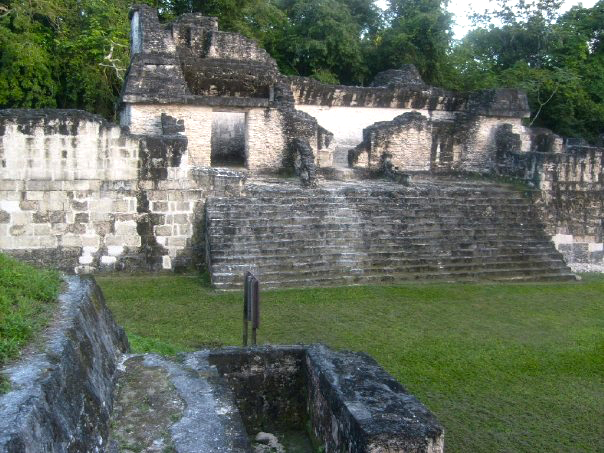Located in the depths of the Guatemalan jungle, Tikal is the home of the ruins of the Mayan Empire. 30 kilometres from the nearest settlement, it is the perfect terrain for the intrepid explorer, with its thousands of ruins littered throughout the rainforest, which also plays host to numerous exotic creatures and uncovered secrets.

Temple I rising out of the canopy (Photo: Will Kitson)
It was 5am. A group of tourists were huddled together in hushed silence; partly because they hadn’t fully woken up yet, partly in reverence for the majesty of the situation. We were sat atop the 1,300 year old Temple IV pyramid in Guatemala, waiting for a sunrise, experiencing first-hand the history of a Mayan Empire that once dominated Central America. And as the sun crept over the horizon and light began to colour the sky, the jungle came to life. First it was through the rasping, dissonant singing of exotic birds, followed by the low rumbling growls of howler monkeys and then, curiously, nothing. ‘Now we’ll hear the jaguar,’ our guide told us. We waited. All of a sudden, the silence was pierced by the fierce roar – not of a big cat but instead of a jeep coming to life. The guide smiled at us. ‘This is Tikal in the 21st century,’ he said. And then, simultaneously, the jungle erupted into a cacophony of sound.
In its day, the ancient city of Tikal was one of the most powerful city-states in the Americas. A bastion of Mayan culture, it was once home to over 60,000 inhabitants, a populace that covered at least 121 square kilometres. Its influence spread from the Yucatán Peninsula of Southeast Mexico to Western Honduras. That was until its mysterious and still unexplained desertion over 1,000 years ago. It’s this cryptic past that makes Tikal one of the most alluring and enigmatic archaeological sites in the world.
Since it was declared a national park in 1955, Tikal has opened its doors to tourism, bringing with it hotels, restaurants and museums. These modern trappings intertwine with the luscious rainforest landscape, highlighting a distinct contrast between the park’s modernity and ancient roots. Overall, the place has a kind of fecund theme park feel to it, and the tourist complex makes it weirdly reminiscent of Jurassic Park. But like the pre-historic, disaster-prone islands envisaged by Michael Crichton there is a promise of adventure that clings to the air.
Call of the Wild

One of the thousands of ancient ruins in Tikal (Photo: Will Kitson)
Upon arrival, I was warned to be alert for roaming jaguar while exploring the grounds. And while that may just be a line they pull out to titillate their guests, I was intrigued. Having spent my first night in a tent and managing to wake up for the famous sunrise tour, I decided to begin searching for wildlife, ultimately hoping to come face-to-face with the elusive black cat.
Wired from lack of sleep and too much coffee, I began roaming the ancient grounds armed with nothing more than a not-to-scale map. I set out upon the routes I deemed the least travelled, not exactly hacking my way through fauna but sleepily meandering across overgrown tracks.
The whole of Tikal is tinged with the expectation of the unknown; the ever-present simmer of exotic animals combined with smatterings of Mayan temples is a surreal experience. The park is home to over 3,000 structures and 200 monuments that lie in wait under the jungle canopy, ranging from 65 metre-high temples to stone pillars carved with hieroglyphs, marking memorable dates from its ancient past.
Roaming between these impressive ruins, 30 kilometres from the nearest settlement, I felt a strange sense of solitude. I rarely passed a fellow tourist and was instead accompanied by an array of local wildlife, from the straggling wild turkeys to the raccoon-like coatimundis.
It was as though I’d entered a sort of timelessness. I felt in tune with the park’s ubiquitous, whinnying call of history; the huge and grotesque carved masks that adorned many of the ruins were reminders of the enigmatic nature of the Mayan culture, into which I was wandering ever deeper. This was a civilisation that treaded the line between ingenious and brutal. Their philosophical studies into celestial events and the cosmos were, in parts, astonishingly accurate given the culture’s level of technology; but on the other hand, their way of life was one of battles, human sacrifice and torture.
This palpable ritualism was both intriguing and unsettling, particularly in the context of my search for the jaguar. It was almost as if the black cat was implicit in Tikal’s secrets and, after a while, I began to wonder whether it was stalking me and not the other way round.
Feeling the hot, rising afternoon sun beat down, I took shelter in the shadow of one of the temples. Above me in the tree-tops was a group of spider monkeys who had been tracing my movements, dropping the occasional flurry of nuts in my direction. They coolly looked down on me, and I decided that I needed to find a new area to explore. Taking out my map, I re-examined the park’s terrain, and spotted an area in the corner of the crumpled page: Lago de Crocodilos. If the jaguar wasn’t going to reveal itself to me, then perhaps another of Tikal’s iconic creatures would be easier to find.
Too Close for Comfort

The Morelet crocodile at Lago de Crocodilos (Photo: Will Kitson)
Maybe it was just that I was coming out of my drowsy state, but as I marched back towards the tourist complex, the surreal sharpness of the jungle seemed to have dulled. The timelessness had faded and I felt more and more like I was returning to 21st century Tikal. The increasing numbers of tourists were less like passing anomalies and more standard features of the park’s landscape. Certainly, by the time I’d reached the tourist hub I felt as though I’d been snapped out of the weird Mayan reverie that had overcome me. However, coming out the other side and making the approach to Lago de Crocodilos introduced me to a new facet of the park’s panorama entirely.
If my experience of the ruin-laden jungle was akin to some sort of strange surreal dream, the path toward the lake was more like strolling through a neglected dog-walking park in the UK; the track was long and unwinding, covered in overgrown, sunburned grass and flanked by dry, thorny bushes. There were no ruins, call-backs to ancient civilisations or spider monkeys; just a kilometre of unwavering path.
The lake itself was equally contrasting to my morning in the rainforest. I was expecting a vast, boggy swamp with seagull-sized dragonflies, but instead found a small pond. Staring into the placid, muddy water, I was about ready to go back along the straight path when I spotted what I’d come looking for. 20 metres across the lake, basking lazily on a bank in the shade, there was a Morelet crocodile: three metres in length, its dark green scales trickling down to its overhanging belly.
I ran to the edge of the lake to get a closer look (the more herpetological reader will immediately know that this is a terrible ‘don’t try this at home’ idea). I stepped in, getting ankle-deep in the pond, oblivious to my own stupidity. The crocodile, however, wasn’t. It began to make its way towards me. Sliding into the water it went from being an awkward, waddling land-dweller to a smooth swimming picture of elegance, pirouetting just below the surface, its tail swishing gracefully behind. I was glued to the spot, mesmerised by its majesty. The crocodile glided closer and closer, eyeing me as it went. It must have been around ten metres away and I still hadn’t moved. And then, just in time, whatever spell I was under was suddenly broken. I bolted out of the haze that had enveloped me all day and jumped back from the lake. With my heart pounding, the crocodile stopped in the water and looked up at me, as if it could feel me coming to my senses. Staring back, I continued retreating towards the path and then turned, quickly making my return to the tourist centre of Tikal.
Unfinished Story

The evening light catching the Temple of the Great Jaguar (Photo: Will Kitson)
Later in the day, I reflected on my idiocy. What had started off as a dream-like exploration could have ended with nightmarish results. I began by looking for a jaguar, but it had remained well-hidden; instead, I’d nearly (and perilously) come face-to-face with another of Tikal’s longstanding inhabitants.
The whole series of experiences fused together into one of unreality, and that was what Tikal became for me. Renowned Mayanist, David Stuart, describes the park in eerie terms, saying that it’s the atmosphere of the place that makes it ‘one of the most overpowering archaeological sites in the world.’ Certainly, for the rest of my stay I couldn’t get away from the idea that I was becoming deeply entrenched in a history that still had so many secrets left to be uncovered.
On my last evening there I watched the sun set from the top of one of the ruins. The sky quickly turned from blood-red to pitch black, and was filled with more stars than I’d ever seen. I tried to wrap my head around Tikal’s vast history: all the events that had and continued to occur there. According to Stuart, there are still many question marks hanging over the Mayan civilisation, and Tikal could well hold some of the answers. There remain nameless, unexcavated mounds just south of an area in the park called ‘The Lost World’. Tikal’s story started well over a thousand years ago, and it’s undoubtedly one that hasn’t finished yet.

At roughly 1,300 years old Temple I rises 47 metres over the Great Plaza (Photo: Will Kitson)